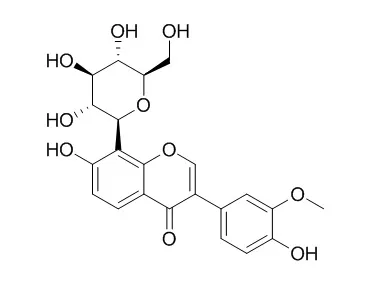| In vitro: |
| Arch. Pharm. Res., 2012, 35(5):823-37. | | Anti-inflammatory and antioxidant activities of constituents isolated from Pueraria lobata roots.[Pubmed: 22644850 ] | In order to evaluate the anti-inflammatory and antioxidant activities of Pueraria lobata roots and its active components, in vitro inhibitory activities against lipopolysaccharide (LPS)-induced nitric oxide (NO) production, inducible nitric oxide synthase (iNOS), cyclooxygenase-2 (COX-2) protein expression, and tert-butylhydroperoxide (t-BHP)-induced reactive oxygen species (ROS) generation in RAW 264.7 cells, as well as in vitro scavenging activities against 1,1-diphenyl-2-picrylhydrazyl (DPPH), peroxynitrite (ONOO(-)), nitric oxide (NO·), superoxide anion (·O(2)(-)) and total ROS, and inhibitory activities against ONOO(-)-mediated tyrosine nitration, were determined.
METHODS AND RESULTS:
Repeated column chromatography was performed to isolate four known compounds from the anti-inflammatory and antioxidant EtOAc fraction: daidzein; genistein; puerarin; (+)-puerarol B-2-O-glucopyranoside; four known compounds from the anti-inflammatory n-hexane fraction: lupenone; lupeol; puerarol; coumestrol; seven known compounds from the antioxidant n-BuOH fraction: allantoin; 3'-hydroxypuerarin; daidzein 8-C-apiosyl-(1→6)-glucoside; puerarin; genistin; 3'-Methoxypuerarin; daidzin. Among these compounds, lupenone and lupeol reduced NO production, as well as iNOS and COX-2 protein levels in LPS-stimulated RAW 264.7 cells. Furthermore, lupeol showed significant inhibitory activity against intracellular ROS generation by t-BHP. Meanwhile, 3'-hydroxypuerarin showed marked ONOO(-), NO·, total ROS scavenging activities, and weak ·O(2)(-) scavenging activity, while 3'-Methoxypuerarin showed ONOO(-) scavenging activity and weak NO· and O(2)(-) scavenging activities, suggesting that existence of the 3'-hydroxyl group in puerarin plays an important role in the scavenging of ONOO(-), NO·, and total ROS, as well as inhibiting the ONOO(-)-mediated tyrosine nitration mechanism.
CONCLUSIONS:
These results indicate that P. lobata roots and its constituents may be a useful therapeutic and preventive approach to various inflammatory diseases and oxidative stress-related disease. |
|






 Cell. 2018 Jan 11;172(1-2):249-261.e12. doi: 10.1016/j.cell.2017.12.019.IF=36.216(2019)
Cell. 2018 Jan 11;172(1-2):249-261.e12. doi: 10.1016/j.cell.2017.12.019.IF=36.216(2019) Cell Metab. 2020 Mar 3;31(3):534-548.e5. doi: 10.1016/j.cmet.2020.01.002.IF=22.415(2019)
Cell Metab. 2020 Mar 3;31(3):534-548.e5. doi: 10.1016/j.cmet.2020.01.002.IF=22.415(2019) Mol Cell. 2017 Nov 16;68(4):673-685.e6. doi: 10.1016/j.molcel.2017.10.022.IF=14.548(2019)
Mol Cell. 2017 Nov 16;68(4):673-685.e6. doi: 10.1016/j.molcel.2017.10.022.IF=14.548(2019)